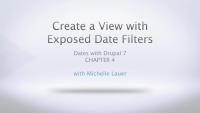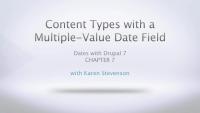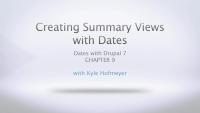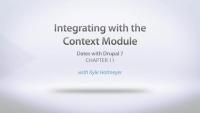This page is archived
We're keeping this page up as a courtesy to folks who may need to refer to old instructions. We don't plan to update this page.
Learning "Dates" in Drupal can help you create event functionality, listing pages with a unique result set, and calendars. The Date Series begins with basic configurations and the contributed modules required to integrate with other functionality. In addition to creating a new content type for our Date field via the wizard, we also explore all possible configuration choices by diving deeper into the date field. Once we have content on our site, we move into displaying the content in unique ways in Views by using basic filters, exposed filters and contextual filters. Other demonstrations in this Series include working with multiple date fields, repeating dates and integrating with the Context module.
If you would like to work along with the video, the entire demo site can be downloaded and set up (it is found on the introduction video's Downloads tab). The zip file includes the Drupal files, the database, and a README.txt file to explain setting it up. The site was created using the Demonstration module so that you can switch back and forth between the finished states of the various chapters.
When you learn how Drupal handles dates, you can create event functionality, listing pages with a unique result set, and calendars. The Dates Series begins with basic configurations and the contributed modules required to integrate with other functionality. In addition to creating a new content type for our Date field via the wizard, we also explore all possible configuration choices by diving deeper into the Date field. Once we have content on our site, we move into displaying the content in unique ways in Views by using basic filters, exposed filters and contextual filters. Other demonstrations in this series include working with multiple date fields, repeating dates and integrating with the Context module.
If you would like to work along with the video, the entire demo site can be downloaded and set up (it is found on the introduction video's Downloads tab). The zip file includes the Drupal files, the database, and a README.txt file to explain setting it up. The site was created using the Demonstration module so that you can switch back and forth among the finished states of the various chapters.
In this chapter, Karen turns on the Date, Date API, and Date tools modules, and walks us through some initial configuration of core date settings, so that we can use Date module properly. We look at the site timezone settings, as well as talk about the core date formats. Then we go ahead and create some new custom date formats and date types.
In this chapter we dive deeper into the Date field and look at all the configuration options that come with the Date field out of the box. We'll also enable the Date All Day and Date Popup modules to see some nice additions to our main Date field.
In this chapter Michelle will walk us through using our new date field with Views to create a listing of our content showing the dates associated with them. We'll be listing our date content, with an exposed filter for selecting the date range, and we look at how to set relative dates to fill in the form's default values.
You'll need to the Views and Chaos Tools modules for this chapter. If you would like a refresher on using Views, you can watch our Intro to Views for Drupal 7 series.
Note: With an update in Date module (7.x-2.x), you can now change the format of the date in the exposed filter. It's not a completely smooth process, but here are some instructions for how to get this working.
1. Ensure that the following modules and their dependencies are enabled: Date, Date Views, Date Popup, Views UI.
2. Add a date field to a content type. Collect only the date (not the time -- uncheck hours, minutes, seconds). Create some content with a date.
3. Create a new view of fields filtered by the content type in which you added a date field.
4. Update the format as described in the video to table and add a label to the Title field.
5. Add the date field to fields. Choose the "short" format to display.
6. Add the date field to filters. Select "day" as granularity.
7. Expose the date filter. Configure it as described in the video.
8. The exposed date filter should show a long format in the text field, which is not what we want.
9. In a new tab, go to Configuration > Regional and Language > Date and time > Types
10. For the Date Type of "Short", select the 2nd option (10/21/2014 - 12:29). Save configuration.
11. Go back to your view and refresh the page. The date popup format should now be in the short format. It should now respect whatever format you choose for "Short" in the Date and Type settings.
In this chapter we continue working with Date filters in Views and look at using the created and updated core date fields.
In this chapter we will walk through using dates as contextual filters, also known as arguments in Drupal-speak. We will create a block which shows us content per month, based on pur date field, and allow users to page through the months.
In this chapter Karen introduces you to using the date field with multiple values. She looks at how to set up a content type with multiple dates, tweak the way they are displayed, and also how to use a multiple-value date in a view.
In this chapter we go one step further with multiple-value date fields, and use the Date Repeat API and Field to create automatically repeating dates. We cover all of the different ways you can configure a repeating date and explain what is going on behind the scenes.
In this video Kyle will show you how to use views to create a summary list block which lists the months and years for our content, and shows how many posts were created in each month/year. We'll be using Views contextual filters and the core date created field.
in this chapter Kyle shows you how to create a view of content which shows the content grouped by the year in which it was created. We'll be making a table view that displays the title and post date, but is also grouped such that there will be one table displayed per year.
In this final video Kyle will show us how to use the Date context module, which comes as a part of the Date project, along with the Context module to display some blocks based on the date associated with the content we are viewing. We create two blocks, one for dates in the future, and another for dates in the past. We then configure Context to display the correct block based on the content's date.










